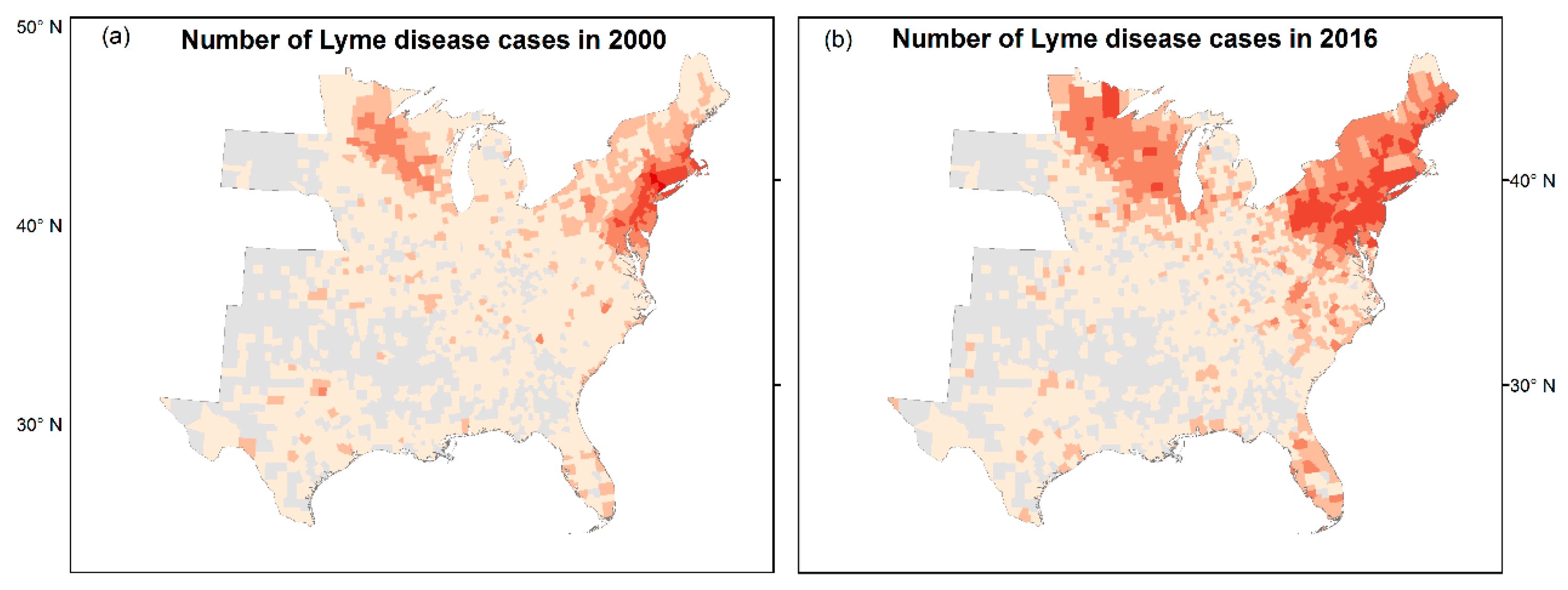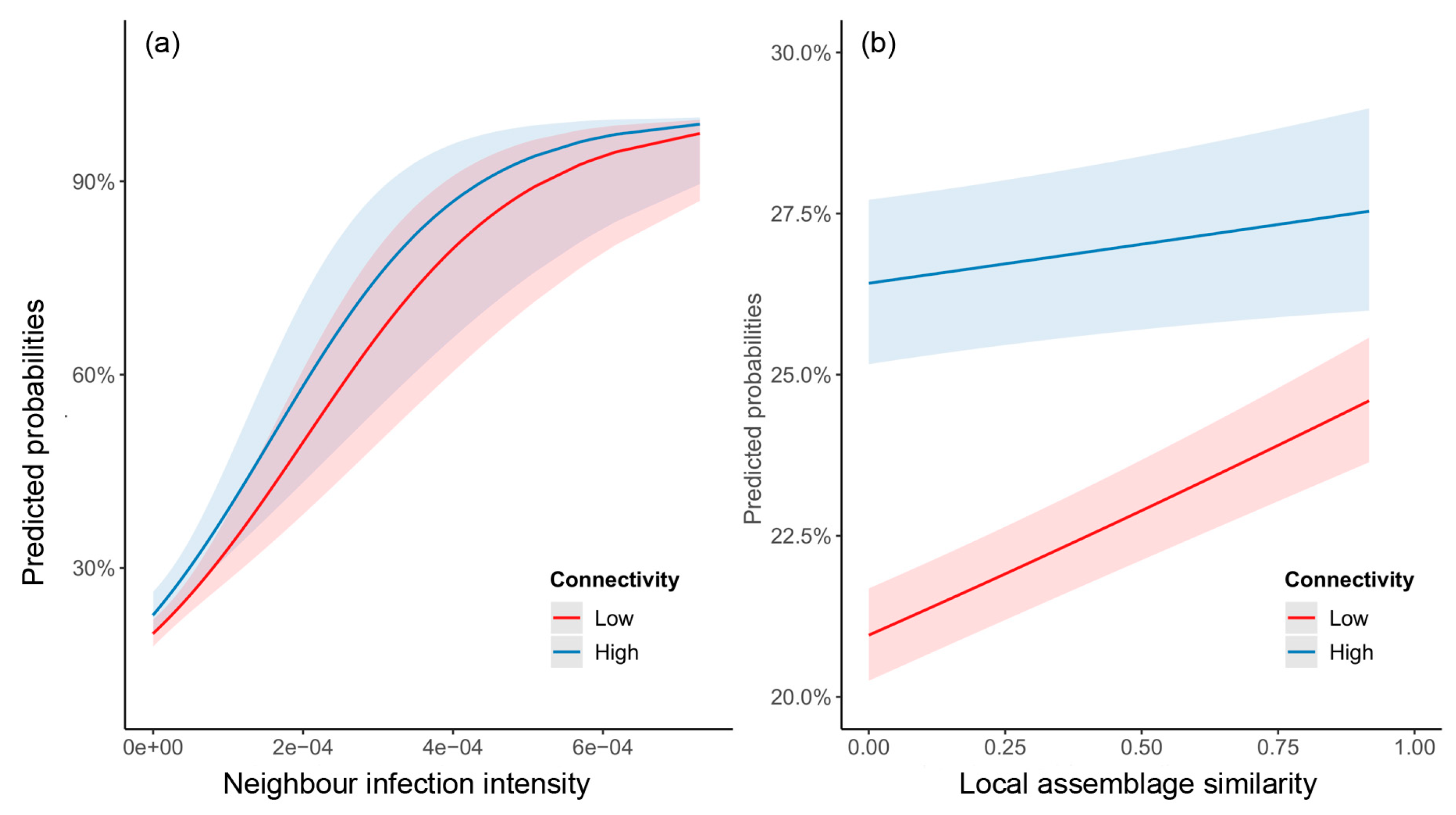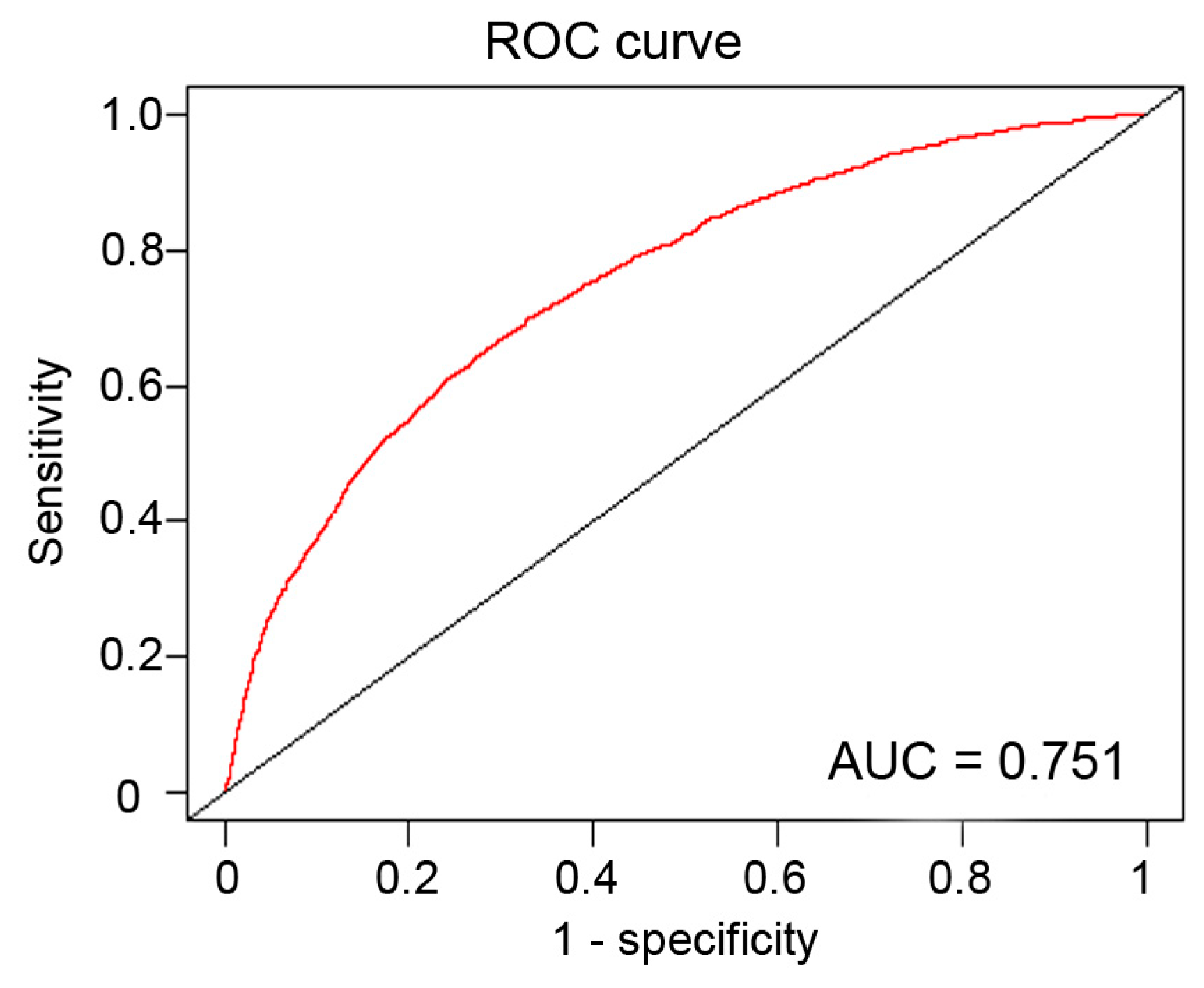Forest Connectivity, Host Assemblage Characteristics of Local and Neighboring Counties, and Temperature Jointly Shape the Spatial Expansion of Lyme Disease in United States
Abstract
1. Introduction
2. Materials and Methods
2.1. Lyme Disease Data
2.2. Explanatory Variables
2.3. Statistical Analyses
3. Results
4. Discussion
5. Conclusions
Supplementary Materials
Author Contributions
Funding
Conflicts of Interest
References
- Smith, D.L.; Lucey, B.; Waller, L.A.; Childs, J.E.; Real, L.A. Predicting the spatial dynamics of rabies epidemics on heterogeneous landscapes. Proc. Natl. Acad. Sci. USA 2002, 99, 3668–3672. [Google Scholar] [CrossRef] [PubMed]
- Estrada-Peña, A. The relationships between habitat topology, critical scales of connectivity and tick abundance. Ecography 2003, 26, 661–671. [Google Scholar] [CrossRef]
- Estrada-Peña, A.; Ostfeld, R.S.; Peterson, A.T.; Poulin, R.; de la Fuente, J. Effects of environmental change on zoonotic disease risk: An ecological primer. Trends Parasitol. 2014, 30, 205–214. [Google Scholar] [CrossRef] [PubMed]
- Kilpatrick, A.M.; Randolph, S.E. Drivers, dynamics, and control of emerging vector-borne zoonotic diseases. Lancet 2012, 380, 1946–1955. [Google Scholar] [CrossRef]
- Reisen, W.K. Landscape Epidemiology of Vector-Borne Diseases. Annu. Rev. Entomol. 2009, 55, 461–483. [Google Scholar] [CrossRef] [PubMed]
- Huang, Z.Y.X.; Van Langevelde, F.; Estrada-Pena, A.; Suzan, G.; De Boer, W.F.W.; Estrada-Peña, A.; Suzán, G.; De Boer, W.F.W. The diversity–disease relationship: Evidence for and criticisms of the dilution effect. Parasitology 2016, 143, 1075–1086. [Google Scholar] [CrossRef] [PubMed]
- Huang, Z.Y.X.; van Langevelde, F.; Prins, H.H.T.; de Boer, W.F. Dilution versus facilitation: Impact of connectivity on disease risk in metapopulations. J. Theor. Biol. 2015, 376, 66–73. [Google Scholar] [CrossRef]
- George Hess Disease in Metapopulation Models: Implications for Conservation. Ecology 1996, 77, 1617–1632. [CrossRef]
- Stapp, P.; Hartley, L.M.; Savage, L.T.; Antolin, M.F.; Reich, R.M. Climate, soils, and connectivity predict plague epizootics in black-tailed prairie dogs (Cynomys ludovicianus). Ecol. Appl. 2011, 21, 2933–2943. [Google Scholar]
- Keeling, M.J. Metapopulation moments: Coupling, stochasticity and persistence. J. Anim. Ecol. 2000, 69, 725–736. [Google Scholar] [CrossRef]
- Turney, S.; Gonzalez, A.; Millien, V. The negative relationship between mammal host diversy and Lyme disease incidence strengthens through time. Ecology 2014, 95, 3244–3250. [Google Scholar] [CrossRef]
- Steere, A.C.; Coburn, J.; Glickstein, L.; Steere, A.C.; Coburn, J.; Glickstein, L. The emergence of Lyme disease. J. Clin. Invest. 2004, 113, 1093–1101. [Google Scholar] [CrossRef] [PubMed]
- Diuk-Wasser, M.A.; Gatewood, A.G.; Cortinas, M.R.; Yaremych-Hamer, S.; Tsao, J.; Kitron, U.; Hickling, G.; Brownstein, J.S.; Walker, E.; Piesman, J.; et al. Spatiotemporal patterns of host-seeking Ixodes scapularis nymphs (Acari: Ixodidae) in the United States. J. Med. Entomol. 2006, 43, 166–176. [Google Scholar] [CrossRef] [PubMed]
- Guerra, M.; Walker, E.; Jones, C.; Paskewitz, S.; Roberto Cortinas, M.; Ashley Stancil, L.B.; Bobo, M.; Kitron, U. Predicting the risk of Lyme disease: Habitat suitability for Ixodes scapularis in the north central United States. Emerg. Infect. Dis. 2002, 8, 289–297. [Google Scholar] [CrossRef] [PubMed]
- Cheng, A.; Chen, D.; Woodstock, K.; Ogden, N.H.; Wu, X.; Wu, J. Analyzing the potential risk of climate change on lyme disease in Eastern Ontario, Canada using time series remotely sensed temperature data and tick population modelling. Remote Sens. 2017, 9, 609. [Google Scholar] [CrossRef]
- Hamer, S.A.; Tsao, J.I.; Walker, E.D.; Hickling, G.J. Invasion of the Lyme disease vector Ixodes scapularis: Implications for Borrelia burgdorferi endemicity. Ecohealth 2010, 7, 47–63. [Google Scholar] [CrossRef]
- Lee, X.; Coyle, D.R.; Johnson, D.K.H.; Murphy, M.W.; McGeehin, M.A.; Murphy, R.J.; Raffa, K.F.; Paskewitz, S.M. Prevalence of Borrelia burgdorferi and Anaplasma phagocytophilum in Ixodes scapularis (Acari: Ixodidae) Nymphs Collected in Managed Red Pine Forests in Wisconsin. J. Med. Entomol. 2014, 51, 694–701. [Google Scholar] [CrossRef]
- Eisen, R.J.; Eisen, L.; Beard, C.B. County-scale distribution of Ixodes scapularis and Ixodes pacificus (Acari: Ixodidae) in the continental United States. J. Med. Entomol. 2016, 53, 349–386. [Google Scholar] [CrossRef]
- Watts, E.J.; Palmer, S.C.F.; Bowman, A.S.; Irvine, R.J.; Smith, A.; Travis, J.M.J. The effect of host movement on viral transmission dynamics in a vector-borne disease system. Parasitology 2009, 136, 1221–1234. [Google Scholar] [CrossRef]
- Guernier, V.; Hochberg, M.E.; Guégan, J.F.F. Ecology drives the worldwide distribution of human Diseases. PLoS Biol. 2004, 2, e141. [Google Scholar] [CrossRef]
- Esser, H.J.; Herre, E.A.; Blüthgen, N.; Loaiza, J.R.; Bermúdez, S.E.; Jansen, P.A. Host specificity in a diverse Neotropical tick community: An assessment using quantitative network analysis and host phylogeny. Parasites Vectors 2016, 9, 1–14. [Google Scholar] [CrossRef] [PubMed]
- Yu, P.; Li, Y.; Xu, B.; Wei, J.; Li, S.; Dong, J.; Qu, J.; Xu, J.; Huang, Z.Y.X.; Ma, C.; et al. Using satellite data for the characterization of local animal reservoir populations of Hantaan virus on the Weihe Plain, China. Remote Sens. 2017, 9, 1076. [Google Scholar] [CrossRef]
- Polo, G.; Labruna, M.B.; Ferreira, F. Satellite hyperspectral imagery to support tick-borne infectious diseases surveillance. PLoS ONE 2015, 10, 1–12. [Google Scholar] [CrossRef] [PubMed]
- Wimberly, M.C.; Baer, A.D.; Yabsley, M.J. Enhanced spatial models for predicting the geographic distributions of tick-borne pathogens. Int. J. Health Geogr. 2008, 7, 1–14. [Google Scholar] [CrossRef] [PubMed]
- Altizer, S.; Dobson, A.; Hosseini, P.; Hudson, P.; Pascual, M.; Rohani, P. Seasonality and the dynamics of infectious diseases. Ecol. Lett. 2006, 9, 467–484. [Google Scholar] [CrossRef] [PubMed]
- Killilea, M.E.; Swei, A.; Lane, R.S.; Briggs, C.J.; Ostfeld, R.S. Spatial dynamics of Lyme sisease: A review. Ecohealth 2008, 5, 167–195. [Google Scholar] [CrossRef]
- Tran, P.M.; Waller, L. Effects of landscape fragmentation and climate on lyme disease incidence in the Northeastern United States. Ecohealth 2013, 10, 394–404. [Google Scholar] [CrossRef]
- Fick, S.; Hijmans, R. Worldclim 2: New 1-km spatial resolution climate surfaces for global land areas. Int. J. Climatol. 2017, 37, 4302–4315. [Google Scholar] [CrossRef]
- Dornelas, M.; Gotelli, N.J.; McGill, B.; Shimadzu, H.; Moyes, F.; Sievers, C.; Magurran, A.E. Assemblage time series reveal biodiversity change but not systematic loss. Science 2014, 344, 296–299. [Google Scholar] [CrossRef]
- IUCN. The IUCN Red List of Threatened Species. Version 2015-3; IUCN: Gland, Switzerland, 2015. [Google Scholar]
- Dixon, P. VEGAN, a package of R functions for community ecology. J. Veg. Sci. 2003, 14, 927–930. [Google Scholar] [CrossRef]
- Zuur, A.F.; Ieno, E.N.; Elphick, C.S. A protocol for data exploration to avoid common statistical problems. Methods Ecol. Evol. 2010, 1, 3–14. [Google Scholar] [CrossRef]
- Gray, J.S.; Dautel, H.; Estrada-Peña, A.; Kahl, O.; Lindgren, E. Effects of climate change on ticks and tick-borne diseases in Europe. Interdiscip. Perspect. Infect. Dis. 2009, 2009, 1–12. [Google Scholar] [CrossRef] [PubMed]
- Medlock, J.M.; Leach, S.A. Effect of climate change on vector-borne disease risk in the UK. Lancet Infect. Dis. 2015, 15, 721–730. [Google Scholar] [CrossRef]
- Lambin, E.F.; Tran, A.; Vanwambeke, S.O.; Linard, C.; Soti, V. Pathogenic landscapes: Interactions between land, people, disease vectors, and their animal hosts. Int. J. Health Geogr. 2010, 9, 54. [Google Scholar] [CrossRef]
- Estrada-Peña, A. Diluting the dilution effect: A spatial Lyme model provides evidence for the importance of habitat fragmentation with regard to the risk of infection. Geospat. Health 2009, 3, 143–155. [Google Scholar] [CrossRef]
- White, L.A.; Forester, J.D.; Craft, M.E. Disease outbreak thresholds emerge from interactions between movement behavior, landscape structure, and epidemiology. Proc. Natl. Acad. Sci. USA 2018, 115, 7374–7379. [Google Scholar] [CrossRef]
- Watts, A.G.; Saura, S.; Jardine, C.; Leighton, P.; Werden, L.; Fortin, M.J. Host functional connectivity and the spread potential of Lyme disease. Landsc. Ecol. 2018, 33, 1925–1938. [Google Scholar] [CrossRef]
- Lloyd-Smith, J.O.; Cross, P.C.; Briggs, C.J.; Daugherty, M.; Getz, W.M.; Latto, J.; Sanchez, M.S.; Smith, A.B.; Swei, A. Should we expect population thresholds for wildlife disease? Trends Ecol. Evol. 2005, 20, 511–519. [Google Scholar] [CrossRef]
- Fountain-Jones, N.M.; Pearse, W.D.; Escobar, L.E.; Alba-Casals, A.; Carver, S.; Davies, T.J.; Kraberger, S.; Papeş, M.; Vandegrift, K.; Worsley-Tonks, K. Towards an eco-phylogenetic framework for infectious disease ecology. Biol. Rev. 2018, 93, 950–970. [Google Scholar] [CrossRef]
- Hofmeester, T.R.; Prins, H.H.T.; Coipan, E.C.; Sprong, H.; van Wieren, S.E.; Takken, W. Few vertebrate species dominate the Borrelia burgdorferi s.l. life cycle. Environ. Res. Lett. 2016, 11, 043001. [Google Scholar] [CrossRef]
- Ostfeld, R.S.; Canham, C.D.; Oggenfuss, K.; Winchcombe, R.J.; Keesing, F. Climate, deer, rodents, and acorns as determinants of variation in Lyme disease risk. PLoS Biol. 2006, 4, e145. [Google Scholar] [CrossRef] [PubMed]
- Jones, C.J.; Kitron, U.D. Populations of Ixodes scapularis (Acari: Ixodidae) are modulated by drought at a Lyme disease focus in illinois. J. Med. Entomol. 2000, 37, 408–415. [Google Scholar] [CrossRef] [PubMed]



| Abbreviation | Variable | Hypotheses |
|---|---|---|
| Local assemblage similarity | The similarity of local host assemblage with neighboring counties | Counties with high similarity of host assemblage with infected neighbors would have a higher risk of disease spread |
| Forest connectivity | Forest habitat connectivity between local county and neighboring county | Counties with high connectivity with infected neighbors would have a higher risk. |
| Neighbor infection intensity | Number of Lyme cases reported in neighboring counties in the previous year | Counties close to heavily infected neighbors would have a higher risk. |
| Bio01, Bio05, Bio10 1 | Temperature-related variables [28] | Higher temperature and precipitation support tick establishment, tick survival, and contribute to the expansion of the distribution range of ticks [33,34]; however, a higher temperature can also decrease tick density by dehydrating ticks [26,27]. |
| Bio12, Bio13, Bio14, Bio16, Bio18 1 | Precipitation-related variables [28] | |
| Human population | Human population size | Counties with high population density may have a high disease risk. |
| Time Period | No. of Counties that Remained Disease-Free | No. of Counties that Transitioned from a Disease-Free to Infected State | % of the Total Number of Counties that Became Infected |
|---|---|---|---|
| 2000–2001 | 616 | 156 | 20% |
| 2001–2002 | 495 | 169 | 28% |
| 2002–2003 | 576 | 155 | 21% |
| 2003–2004 | 555 | 137 | 20% |
| 2004–2005 | 553 | 156 | 22% |
| 2005–2006 | 514 | 126 | 20% |
| 2006–2007 | 450 | 186 | 29% |
| 2007–2008 | 510 | 171 | 25% |
| 2008–2009 | 490 | 165 | 25% |
| 2009–2010 | 484 | 134 | 22% |
| 2010–2011 | 441 | 137 | 24% |
| 2011–2012 | 443 | 198 | 31% |
| 2012–2013 | 403 | 167 | 31% |
| 2013–2014 | 425 | 158 | 27% |
| 2014–2015 | 395 | 171 | 30% |
| 2015–2016 | 398 | 171 | 30% |
| Mean ± S.D. | 484 ± 64.9 | 160 ± 18.7 | 25% ± 4% |
| Variables | AOR | 95% CI | P |
|---|---|---|---|
| Neighbor infection intensity | 1.49 | [1.40, 1.61] | <0.001 |
| Forest connectivity | 1.08 | [1, 1.15] | 0.05 |
| Local assemblage similarity | 1.15 | [1.08, 1.22] | <0.001 |
| Neighbor infection intensity * Habitat connectivity | 1.10 | [1.02, 1.17] | 0.01 |
| Local assemblage similarity * Habitat connectivity | 0.90 | [0.85, 0.96] | 0.01 |
| Mean temperature | 0.43 | [0.40, 0.46] | <0.001 |
| Precipitation of warmest quarter | 1.27 | [1.20, 1.38] | <0.001 |
© 2019 by the authors. Licensee MDPI, Basel, Switzerland. This article is an open access article distributed under the terms and conditions of the Creative Commons Attribution (CC BY) license (http://creativecommons.org/licenses/by/4.0/).
Share and Cite
Wang, Y.X.G.; Matson, K.D.; Xu, Y.; Prins, H.H.T.; Huang, Z.Y.X.; de Boer, W.F. Forest Connectivity, Host Assemblage Characteristics of Local and Neighboring Counties, and Temperature Jointly Shape the Spatial Expansion of Lyme Disease in United States. Remote Sens. 2019, 11, 2354. https://doi.org/10.3390/rs11202354
Wang YXG, Matson KD, Xu Y, Prins HHT, Huang ZYX, de Boer WF. Forest Connectivity, Host Assemblage Characteristics of Local and Neighboring Counties, and Temperature Jointly Shape the Spatial Expansion of Lyme Disease in United States. Remote Sensing. 2019; 11(20):2354. https://doi.org/10.3390/rs11202354
Chicago/Turabian StyleWang, Yingying X. G., Kevin D. Matson, Yanjie Xu, Herbert H. T. Prins, Zheng Y. X. Huang, and Willem F. de Boer. 2019. "Forest Connectivity, Host Assemblage Characteristics of Local and Neighboring Counties, and Temperature Jointly Shape the Spatial Expansion of Lyme Disease in United States" Remote Sensing 11, no. 20: 2354. https://doi.org/10.3390/rs11202354
APA StyleWang, Y. X. G., Matson, K. D., Xu, Y., Prins, H. H. T., Huang, Z. Y. X., & de Boer, W. F. (2019). Forest Connectivity, Host Assemblage Characteristics of Local and Neighboring Counties, and Temperature Jointly Shape the Spatial Expansion of Lyme Disease in United States. Remote Sensing, 11(20), 2354. https://doi.org/10.3390/rs11202354






